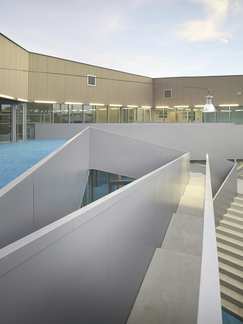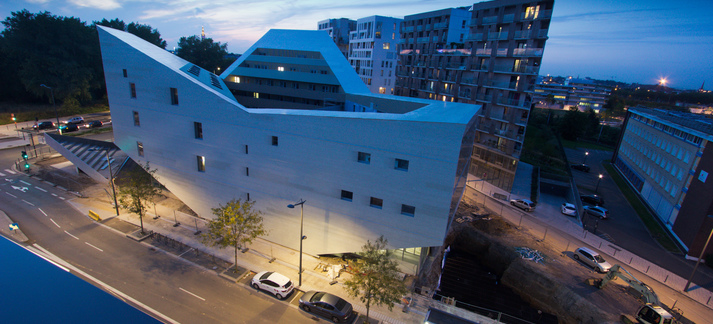-


Maison Hessel
The brief for Lille’s Maison Stéphane Hessel called for the design of a building which would serve three main functions: a 200-bed youth hostel, a creche for up to 70 children, and government-sponsored incubator for social and economic innovation.
©Julien Lanoo
Architect JDSA Architects Location Lille - France Company involved ArcelorMittal Construction Website http://ds.arcelormittal.com/construction
With the site surrounded by three roads, the response from JDSA Architects was to design a building made up of three separate triangles. Each of the three functions is accommodated in a different corner of the building. They are linked by a central cloister which acts as a common area.
Inside, the ground floor accommodates functions such as a restaurant, exhibition space, and conference centre. The entire façade at this level is made from glass, allowing the building and its occupants to connect with the local neighbourhood.
To give each part of the building its own character, JDSA decided to ‘cut’ the end corner of each triangle. This gives each function its own unique façade as well as an entrance area to manage the flow of people.
By lifting each corner of the triangle, JDSA ensured that the three areas had access to natural light and views to the world outside the building. It also maximises the visual and social interaction between the three spaces while respecting the independence of each.
On the raised top levels, terraces were created on the youth hostel and creche volumes to maintain the connections between the functions. The creche terrace is used as an outdoor play area for the children, while the cascading terraces of the youth hostel face south, allowing guests to enjoy direct sunlight for most of the day. By contrast, the roof covering the incubator offices is sloped to capture diffuse light, thereby illuminating the office space naturally for most of the day.
The youth hostel facade features plastic sheets which represent the different flags of the countries that belong to the European Union. The colours are a nod to the European ‘barcode’ flag design proposed by Dutch architect Rem Koolhaas in 2002. The colourful design also identifies the building from the street, making it easy to locate in the busy urban landscape.
The walls and terraces on the interior facade are clad in Trapeza® 7 96 56 gold perla 11B5, from ArcelorMittal Construction. The colour chosen, Gold Perla, helps to reflect natural light into the cloister and onto the terraces of the creche and youth hostel.
A key advantage of Trapeza cladding is its trapezoidal surface. This gives the interior facade a textured appearance and avoids large flat walls. Different sheets can be overlaid to create a totally homogenous façade.
Trapeza is extremely easy to place thanks to its relatively light weight. A simple steel structure is all that is needed to support the facade, reducing its total weight significantly.
The Maison Stéphane Hessel was officially opened in November 2015. Thanks to its innovative design and reflective pre-painted metal cladding the building is very sustainable yet socially generous.
@ Julien Lanoo










